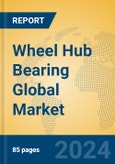Market Size and Growth Forecast
The global Wheel Hub Bearing market is estimated at USD 9.5 billion to USD 10.5 billion in 2025, with a CAGR of 5% to 7% through 2030, potentially reaching USD 12.5 billion to USD 14 billion. Growth stems from automotive production and aftermarket demand.Regional Analysis
- North America: Expected at 4% to 6%, the U.S. and Mexico lead. Trends align with USMCA, boosting local production.
- Europe: Forecasted at 3% to 5%, Germany dominates with premium vehicles. Trends focus on lightweight bearings for EVs.
- Asia Pacific: Projected at 6% to 8%, China drives volume. Trends emphasize efficiency for mass-market and EV growth.
- South Ameica: Anticipated at 4% to 6%, Brazil grows steadily. Trends favor aftermarket expansion.
- Middle East and Africa: Expected at 3% to 5%, South Africa leads. Trends target durable bearings for rugged conditions.
Application Analysis
- OEM Market: Projected at 5% to 7%, it drives volume via new vehicle production. Trends focus on EV integration.
- Aftermarket: Expected at 4% to 6%, it thrives on replacements. Trends emphasize durability and availability.
Product Type Analysis
- Ball Type: Projected at 4% to 6%, valued for smoothness and cost. Trends favor lightweight designs.
- Roller Type: Expected at 6% to 8%, preferred for heavy loads. Trends shift toward high-speed applications.
Key Market Players
- SKF: A Swedish leader, SKF excels in durable bearings.
- Schaeffler: A German giant, Schaeffler targets premium vehicles.
- Timken: A U.S. firm, Timken focuses on heavy-duty solutions.
- NSK: A Japanese player, NSK drives high-speed innovation.
- NTN: A Japanese entity, NTN serves global OEMs.
- JTEKT: A Japanese leader, JTEKT refines lightweight designs.
- Nachi-Fujikoshi: A Japanese firm, Nachi boosts efficiency.
- Zhejiang Sling: A Chinese player, Sling scales production.
- Radical: A producer, Radical serves regional markets.
- Shuanglin Group: A Chinese entity, Shuanglin supports OEM growth.
Porter’s Five Forces Analysis
- Threat of New Entrants: Low, due to high technical and capital barriers.
- Threat of Substitutes: Low, with few viable alternatives to bearings.
- Bargaining Power of Buyers: High, as automakers demand cost and quality.
- Bargaining Power of Suppliers: Moderate, with steel and component providers holding sway.
- Competitive Rivalry: Intense, driven by innovation and scale among SKF and NSK.
- Impact of Tariff Conflicts on Supply Chain Localization
This shift ensures tariff-free access, stabilizes supply amid trade tensions, and speeds delivery to markets like the U.S. and Germany. Yet, it demands investment in regional facilities, compliance with local standards, and workforce training, pressuring short-term margins. Long-term, it enables tailored roller bearings for heavy vehicles or lightweight ball types for EVs, enhancing resilience in a trade-sensitive sector.
Market Opportunities and Challenges
Opportunities
- EV Growth: Rising electric vehicle production boosts demand for efficient bearings.
- Aftermarket Expansion: Aging vehicle fleets drive replacement needs.
- Lightweight Trends: Miniaturization aligns with fuel efficiency goals.
- Regional Production: USMCA fosters North American growth.
- Innovation: High-speed bearings open premium segments.
Challenges
- Cost Pressures: OEMs push for lower prices, squeezing margins.
- Trade Compliance: USMCA rules complicate global sourcing.
- Raw Material Costs: Steel price volatility impacts profitability.
- Technical Barriers: High R&D costs limit new entrants.
- Competition: Scale and innovation intensify rivalry.
This product will be delivered within 1-3 business days.
Table of Contents
Companies Mentioned
- SKF
- Schaeffler
- Timken
- NSK
- NTN
- JTEKT
- Nachi-Fujikoshi
- Zhejiang Sling
- Radical
- Shuanglin Group








